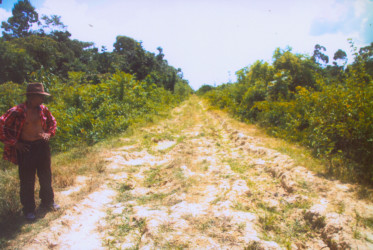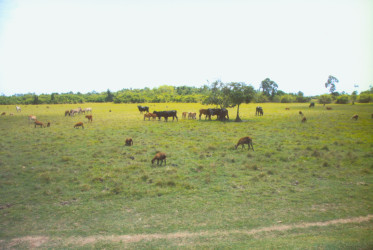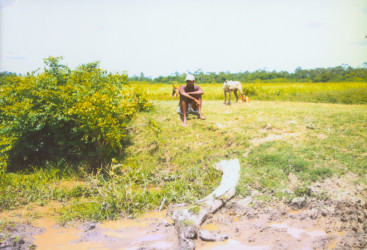Black Bush Polder is, simultaneously, a major rearer of both rice and cattle. The two have shared the community’s vast agricultural lands though, the residents say, the relationship has been an uneasy one.
Cattle and rice are ‘joined at the hip,’ so to speak, thrown together by the need on either side to utilize vast areas of land. As many of the Black Bush residents see it, co-existence is difficult if not impossible. Sometimes, differences between the two sides transform into open conflict.
Kamaldai Williams and her two sons Elvis and Moses are cattle farmers. They tend around 600 head of cattle in the Kokerite savannahs of Black Bush. Every morning Elvis and Moses must make the roughly 10-mile trek to the savannahs to monitor the movement of the cattle. The reason they say is that encroachment on the savannah cattle lands by rice farmers means that grazing grounds are contiguous to rice fields…and the cattle, it seems, have cultivated a taste for rice.
There has long been a raging controversy over issues of territory between the rice and the cattle farmers. The conventional understanding is that rice farming is restricted to the ‘front lands’: Lesbeholden, Johanna, Mibicuri and Yakusari whilst the two-mile long ‘backlands’ are the domain of the cattle.


Several cattle farmers each tend several hundred head of cattle in what has become a confined space and they say that the differences arising out of conflict over space grows worse.
Much of the reason for the trek that Elvis and Moses must make has to do with conflict avoidance. They must police a ‘border’ that separates rice from cattle since if the cattle were to ‘encroach’ on the rice fields they run the risk of being impounded. Some rice farmers, they say, have even been known to shoot cattle that venture into the rice fields.
The cattle farmers have their grouses too. Their business pursuits have become seriously compromised by what they say has been the destruction of the dams used to move their cattle in and out of the savannahs by the tractors used to plough the rice fields. “Kamaldai and another cattle farmer, Peter Crawford, told Stabroek Business that a trip from the frontlands to the backdam now takes twice as long as it used to. There is a direct economic cost here. With buyers unable to use the dams to transport cattle by truck out of the savannahs, cattle farmers must walk their animals out to a point where sales can be completed.
Water too, has become an issue. The irrigation of rice lands results in considerable encroachment of water on the cattle areas. The land becomes soft and soggy and the cultivation of the antelope grass to feed the cattle becomes difficult. Access to the cattle has also made the provision of veterinary services difficult.
Crawford and another cattle farmer, Romel Sancharran told Stabroek Business that some time ago former Minister of Agriculture Dr. Leslie Ramsammy had pronounced on the problem and that his pronouncement had been that the backlands are cattle territory. That has changed nothing. The cattle farmers say that the advent of rice in the backlands is a function of nepotistic practices that have allowed well-off supporters of the previous political administration to have privileged access to cattle lands for rice cultivation. Stabroek Business was provided with the name of one such person whom it was told has been given access to one thousand acres of backlands for rice cultivation.

By contrast, Mohammed Kuyume Azinulla known as `Koyo’ tends 50 head of cattle on the frontlands of Johanna. He accepts that he should be in the backlands but says that efforts to secure areas in the backlands for his cattle have proved fruitless.
The dairy industry, Crawford says, ought to be a thriving one in the Black Bush Polder community. However, the differences between the cattle and rice farmers and the attendant condition of the access dam have meant that the movement of milk to markets has become difficult. Time was when Crawford would sell a modest quantity of milk (approximately 15 gallons) every day. That, he says, no longer makes economic sense.
The cattle farmers are pressing for a visit from some high-level government official to ensure that the problem is dealt with. Otherwise, they say, there is bound to be worsening conflict between the two sides.
Beef originating in Black Bush Polder is sold mostly to markets in Port Mourant, Rose Hall and Georgetown. The cattle are brought out from the backlands to the Johanna/Three Friends Bridge where they are loaded onto vehicles and transported to their respective marketplaces.
Upward price movements in recent years have seen a growing interest in investment in the industry. Whereas three years ago the farmers were being paid $180 per pound for their beef, market demand has pushed prices up as high a $320 per pound. There is, it seems, a healthy competition ensuing between the Black Bush cattle farmers and their counterparts in Essequibo.





